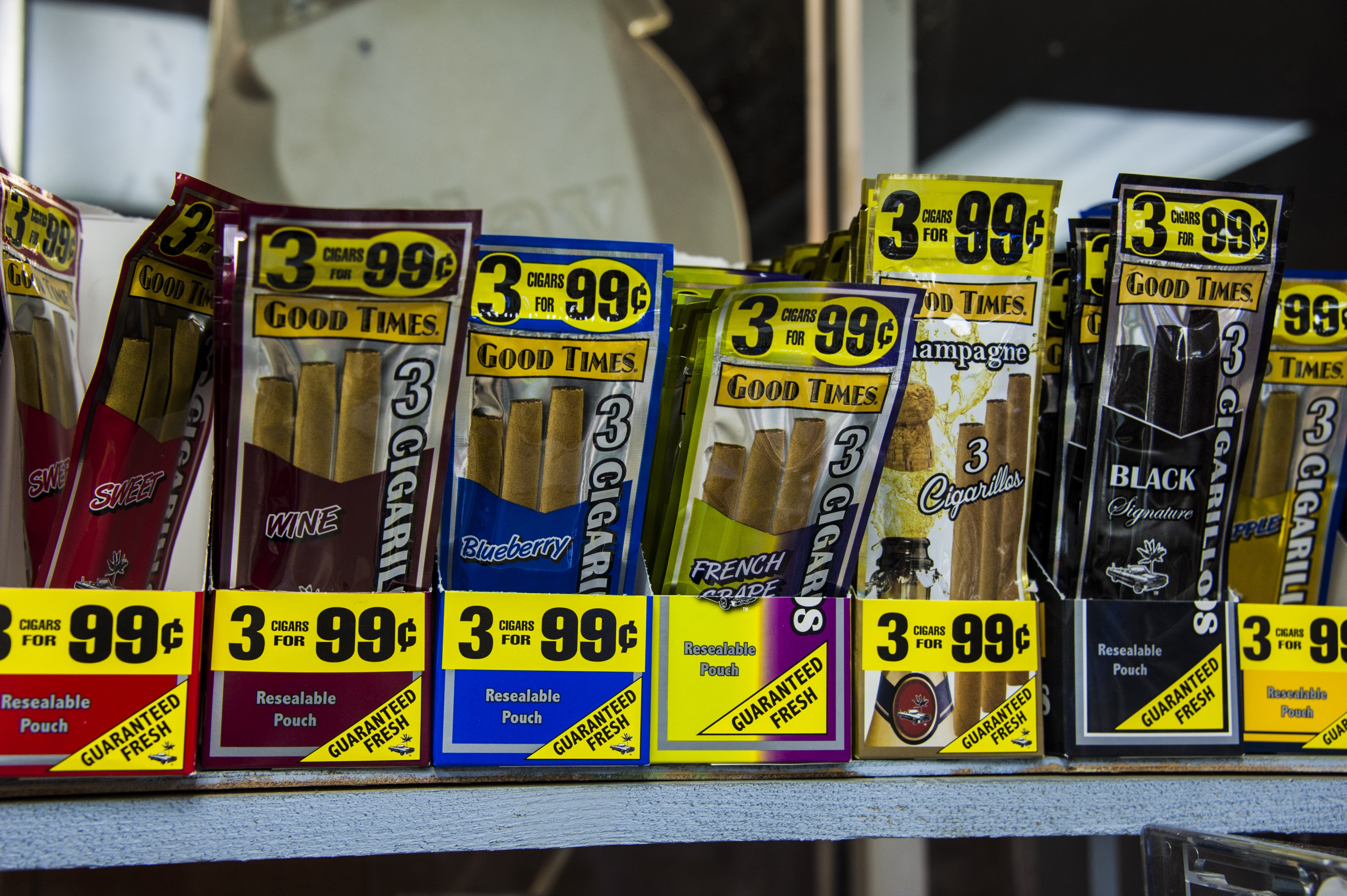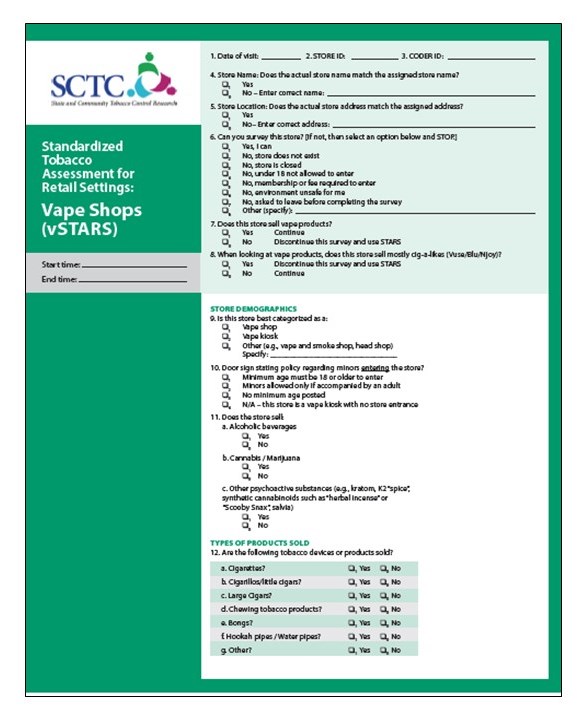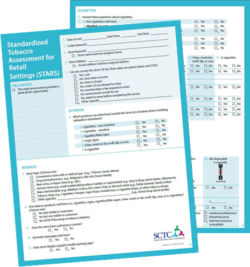Each month we post a summary of the latest research, reports, and news stories on counteracting tobacco product sales and marketing at the point of sale (POS). Keeping up with what’s happening in the POS movement all across the country can help you choose policies and strategies that work best for your community. New research can help provide support for your work and evidence for the importance of the “War in the Store.” Have a story you don’t want us to miss? E-mail it to us!
New Research
POS Policy Progress and Enforcement
- The effects of assurances of voluntary compliance on retail sales to minors in the United States: 2015-2016, Preventive Medicine
- This study found that retail violation rates for sales for minors varied greatly by store type, with gas stations from oil companies at 18.9%, convenience stores at 14.3%, supermarkets at 8%, and pharmacy stores at 7..7%. However, convenience stores that had entered into Assurances of Voluntary Compliance (AVC) had 25% lower odds of a violations for sales to minors, and supermarkets with an AVC had 26% lower odds of a violation. While no significant difference was found for gas stations from oil companies or pharmacies, gas stations from oil companies are often owned and operated by individuals and the corporations have less control over the stores. Pharmacies have low retail violation rates to start with. The researchers suggest that AVCs may complement other compliance checks in efforts to reduce sales to minors. Learn more about AVCs as a tool for tobacco control.
- Attitudes towards Potential New Tobacco Control Regulations among U.S. Adults, International Journal of Environmental Research and Public Health
-
Fruit-flavored cigarillos A nationally representative survey conducted between September 2014 and May 2015 showed the majority of US adults support reducing nicotine in cigarettes (71%) and banning candy and fruit flavors in both e-cigs (54.4%) and little cigars and cigarillos (56.4%). Fewer participants (33.5%) were in favor of banning menthol in cigarettes, though about one-fifth (17.3%) were unsure of their position. The FDA has expressed interest in all four of these policies. Participants were more likely to be in favor of the policies if they were female, non-white, Latino, living below the poverty line, had less than a high school education, were of older age, did not smoke, had higher trust in government, and were exposed to national tobacco control campaigns.
-
- Slapped with a fine or a slap on the wrist? Enforcing tobacco licensing legislation, Tobacco Control
- The WHO Framework Convention on Tobacco Control recommends prohibiting tobacco product displays. However, to enforce this as a policy, a jurisdiction needs a list of retailers selling tobacco, which can be accomplished through tobacco retailer licensing. In order for enforcement to be effective, it needs to both be frequent enough and have strong enough penalties to dissuade retailers from violations, including increasing penalties (including fines and license suspension or revocation) for repeat violations. Learn more about effective tobacco retailer licensing.
- State-Level Point-of-Sale Tobacco News Coverage and Policy Progression Over a 2-Year Period, Health Promotion Practice
- An analysis of point-of-sale tobacco control newspaper content over a two-year period (2012-2014) found that a high volume of content, having a public health source, having a local source and a local angle to the article, and having a pro-tobacco control slant were all associated with a higher level of implementation of state-level point-of-sale tobacco control policies. While these relationships did not remain significant after factoring in baseline policy implementation scores and other contextual variables, news coverage may help gage point-of-sale policy progress.
- Identification of flavor additives in tobacco products to develop a flavor library, Tobacco Control
-

What counts as a flavor? This study used headspace gas chromatography-mass spectrometry to measure chemical compound present in both tobacco products expected to have a characterizing flavor and those not expected to have a characterizing flavor. Researchers found 144 chemical compounds present that were not present in products like natural tobacco leaves and research cigarettes with no flavor additives. The researchers developed a method to identify and describe flavor additives, including which chemical compounds produce what flavors. This may be useful in regulations for flavored tobacco products, including distinguishing between characterizing and non-characterizing levels of flavor. Learn more about flavored tobacco products.
-
Prices and Price Discounts
- Sales Trends in Price-Discounted Cigarettes, Large Cigars, Little Cigars, and Cigarillos – Unites States, 2011-2016, Nicotine & Tobacco Research
- Retail scanner data collected between September 2011 and January 2016 show that of tobacco product sales, 11.3% of cigarette, 3.4% of large cigar, 4.1% of little cigar, and 3.9% of cigarillos sales included a price discount. For cigarettes, these discounts resulted in 25.5% lower prices at convenience stores and 36.7% lower prices at other types of stores. For large cigars the discounts resulted in 11% lower prices at convenience stores and 11.2% lower prices at other stores. For little cigars, the discounts resulted in 19.2% lower prices at convenience stores and 9.6% lower prices at other stores. For cigarillos, the discounts resulted in 5.3% lower prices at convenience stores and 14.7% lower prices at other stores. Of the price discounted sales, 36% of cigarette, 7.4% of large cigar, 7.7% of little cigar, and 4.2% of cigarillo sales were of top-selling brands. Given the strong ties between price and tobacco use behaviors, this study highlights the importance of policies such as minimum price laws and discount bans that mitigate tobacco companies attempts to keep prices low. Learn more about minimum price laws and prohibiting price discounts.
- Sources and Number of Coupons for Cigarettes and Snus Received by a Cohort of Young Adults, American Journal of Health Promotion
-
coupons accepted here Among a group of Midwestern young adults ages 22-28, a 2012-2013 survey showed that within the past six months, 11% had received coupons for cigarettes, 5% had received coupons for snus, 3% had received coupons for smokeless tobacco, and <1% had received coupons for little cigars. While direct mail was the most common way that the young adults received coupons for cigarettes and snus, current and former smokers received the most coupons through tobacco product packaging. Those with lower levels of education and racial/ethnic minorities both received more coupons. The study also found that receiving coupons for snus was associated with susceptibility to using the product.
-
- E-cigarette Price Sensitivity Among Middle and High School Students: Evidence from Monitoring the Future, Addiction
- Using a regression model, data from the Monitoring the Future Study, and Nielsen scanner data, researchers estimated the effects of changes in e-cigarettes and cigarette prices on e-cigarette use among middle and high school students. They found that a 10% increase in disposable e-cigarette prices was associated with a 9.7% decrease in number of days vaping among e-cigarette users and a 17.9% decrease in days vaping among all students. Neither the price of e-cigarette refills nor the price of cigarettes had a significant impact on e-cigarette use with market fixed effects. However, without market fixed effects, a 10% increase in cigarette prices was associated with an increase in total e-cigarette demand by 3.5%. Overall, the researchers concluded that higher disposable e-cigarette prices can reduce e-cigarette use among adolescents.
Disparities
- Tobacco Product Use Among Military Veterans – United States, 2010-2015, CDC Morbidity and Mortality Weekly
-
Targeted advertising Data from the 2010-2015 National Survey on Drug Use and Health show that 29.2% of veterans were current tobacco users. Cigarettes were the most common product, used among 21.6% of veterans. However, 7% of veterans also reported using two or more tobacco products. In addition, rates of use were higher among veterans who were younger (56.8%), Hispanic (34%), those who had not completed high school (37.9%), those who were lower income (44.3%), those with serious psychological distress (48.2%), and those with no health insurance (60.1%).
-
- Prevalence and Disparities in Tobacco Product Use Among American Indians/Alaska Natives – United States, 2010-2015, Morbidity and Mortality Weekly Report
- American Indians/Alaska Natives (AI/AN) continue to have one of the highest rates of cigarette smoking of all racial/ethnic groups at 43.3% for any tobacco product, 37.3% for cigarettes, 7.1% for roll-your-own, 1.9% for pipes, and 6.6% for smokeless. Among AI/AN individuals, males, younger adults, those with lower levels of education and lower levels of income, and those who have never been married are more likely to use tobacco. While tobacco has long been part of some tribes’ culture, commercial tobacco is increasingly being used instead. Prices for tobacco are also cheaper on reservations, which may be contributing to high rates of consumption. In addition, commercial tobacco companies target AI/AN groups with cultural icons used in marketing. Both addressing inequalities in education and income among AI/AN and culturally appropriate strategies are needed to reduce disparities in rates of tobacco use among the AI/AN population.
- Ethnic and Socioeconomic Disparities in Recalled Exposure to and Self-Report Impact of Tobacco Marketing and Promotions, Health Communication
- Data from the Population Assessment of Tobacco and Health study show that youth who are African-American or of lower socioeconomic status were more than twice as likely to recall seeing ads for cigarettes and little cigars and more likely to report that marketing and promotion play a role in their tobacco product use. Lower SES youth were also more likely to report exposure to discount coupons and sweepstakes.
- Learn more about disparities in point of sale advertising.
Point of Sale Communications and Signage
- Placing Antismoking Graphic Warning Posters at Retail Point-of-Sale Locations Increases Some Adolescents’ Susceptibility of Future Smoking, Nicotine & Tobacco Research
- News story: Graphic Anti-Smoking Ads Can Backfire on Kids, HealthDay
- This study found that introducing graphic antismoking posters at POS may have the unintended effect of further increasing susceptibility to future cigarette smoking among adolescents already at risk, though the posters had no effect on committed never smokers. One possible mechanism for this could be that at-risk adolescents looked away from the graphic warning images displayed near the power wall or cash register and thus spent more time looking at the cigarette displays. The increase in smoking susceptibility could also have been due to defensive reactance from participants. Learn more about point-of-sale health warnings.
- Developing a Point-of-Sale Health Communication Campaign for Cigarillos and Waterpipe Tobacco, Health Communication
- Exposure to a message that identified a tobacco product (waterpipe tobacco or cigarillos) and a constituent in its smoke, included an image of an unappealing product containing the constituent (e.g., pesticides, gasoline) to grab attention, and used a humorous sarcastic tone was associated with increases in risk beliefs for that product. This study documents the process of developing and testing this message, which could help discourage waterpipe tobacco and cigarillo use among adolescents.
Other
- Using the Vape Shop Standardized Tobacco Assessment for Retail Settings (V-STARS) to Assess Product Availability, Price Promotions, and Messaging in New Hampshire Vape Shop Retailers, Tobacco Regulatory Science
-

vSTARS In New Hampshire, a statewide census of vape shops was conducted using the Vape Shop Standardized Tobacco Assessment for Retail Settings (vSTARS) tool to assess product availability, price promotions, and product messaging. Results showed that vape shops try to distinguish themselves from conventional tobacco retailers. Candy/fruit and menthol e-liquids were the most common flavors found. Self-service sampling displays were available in one-fifth of stores and 83.6% of stores offered some sort of sampling Messages promoting e-cigarettes for cessation was found in 27.3% of stores. Researchers conclude that regulations that ensure health messaging that is accurate is a critical need. Learn more about vSTARS.
-
- The geography of crime and violence surrounding tobacco shops, medical marijuana dispensaries, and off-sale alcohol outlets in a large, urban low-income community of color, Preventive Medicine
- This study assessed the location of tobacco shops, medical marijuana dispensaries, and off-sale alcohol outlets in South Los Angeles, California. They found that property and violent crime rates were higher within a 100ft buffer of alcohol and tobacco shops than in the surrounding community or around grocery and convenience stores.
- News Story: Tobacco shops associated with crime in urban communities of color, EurekAlert!
- Association of Noncigarette Tobacco Product Use With Future Cigarette Smoking Among Youth in the Population Assessment of Tobacco and Health (PATH) Study, 2013-2015, JAMA Pediatrics
- An analysis of data collected between 2013 and 2015 through the Population Assessment of Tobacco and Health study found that of youth ages 12-17 who had never smoked a conventional cigarette at baseline, Those who had ever used a noncigarette tobacco product (e.g. e-cigarettes, hookah, smokeless tobacco, or little cigars or cigarillos) at baseline were nearly twice as likely to report having used cigarettes within the past 30 days at follow-up. Youth who had tried more than one type of tobacco product at baseline were over three times as likely to have used cigarettes within the past 30 days at follow-up compared to those who had never used any tobacco at baseline.
- News story: Teens who try tobacco products that aren’t cigarettes are twice as likely to try cigs a year later, CNBC
- Is a cigarette pack just a wrapper or a characteristic of the product itself? A qualitative study of adult smokers to inform U.S. regulations, Journal of Cancer Policy
 Focus groups with diverse adult smokers found that participants believe that the design of a cigarette pack reflects the product, and they believe that when there is a design change of the package, that means that the cigarettes have changed, too. There is federal debate over whether a change in the packaging of a tobacco product requires review by the FDA, even if the product has not changed. The results of this study provide support for this review, in that the change in packaging may influence smokers’ or other consumers’ perceptions of the product and their behavior towards it. Smokers may view the package change as a new product or as lighter or healthier product. While some participants felt that they were influenced more by price than by the design of the pack, they also thought that young or new smokers may be more influenced by pack design.
Focus groups with diverse adult smokers found that participants believe that the design of a cigarette pack reflects the product, and they believe that when there is a design change of the package, that means that the cigarettes have changed, too. There is federal debate over whether a change in the packaging of a tobacco product requires review by the FDA, even if the product has not changed. The results of this study provide support for this review, in that the change in packaging may influence smokers’ or other consumers’ perceptions of the product and their behavior towards it. Smokers may view the package change as a new product or as lighter or healthier product. While some participants felt that they were influenced more by price than by the design of the pack, they also thought that young or new smokers may be more influenced by pack design.
- Commentary: The changing nicotine products landscape: time to outlaw sales of combustible tobacco products?, Tobacco Control
- Harm Minimization and Tobacco Control: Reframing Societal Views of Nicotine Use to Rapidly Save Lives, Annual Review of Public Health
Industry News
- Reynolds enters FDA modified-risk tobacco gauntlet with Camel Snus styles, Winston-Sale Journal
- How Chesterfield’s Avail is vaporizing the cigarette market, Chesterfield Observer
- Juul continues to expand e-cig market share gap with Vuse; Newport keeps ticking up, Winston-Salem Journal
POS Policy in the Media
-

The STARS form can help monitor tobacco marketing Commentary: Philip Morris Says It Wants to Quit Cigarettes. But It’s Just Blowing Smoke, Fortune
- BC Reality Check, JC Mayor Deemie visit convenience stores to learn about tobacco marketing, Binghamton
- Hempstead Town Bans New Hookah Bars Near Homes, Schools, Merrick Patch
- Anti-Smoking Plan May Kill Cigarettes – and Save Big Tobacco, New York Times
- Washington City bans new specialty tobacco shops, St. George News
Tobacco 21
- San Antonio becomes first city in Texas to raise legal age to buy tobacco to 21, My San Antonio
- Bedford raises tobacco purchasing age to 21 in 2018, Wicked Local Bedford
- Springfield City Council approves age 21 requirement for buying tobacco, Mass Live
- Florida may raise tobacco-buying age to 21, Orlando Sentinel
- Burlington City Council approves ballot measure on raising the age, My Champlain Valley
- Why the legal age to buy tobacco isn’t going up to 21 everywhere, Daily Herald
- Arizona bill would raise age for tobacco, e-cigs to 21, AZ Family 3TV-CBS 5
- Bill seeks to raise Idaho’s smoking age from 18 to 21, Q13 Fox
Disparities
- Where’s Our Ad? Big Tobacco Still Hasn’t Apologized to Black America, Milwaukee Courier
- American Indians in Minnesota reclaiming traditional tobacco, Star Tribune
Flavored Tobacco Products
- Ordinance May Restrict Flavored Tobacco Products in Duluth Convenience Stores, Fox 21
- Contra Costa County to Begin Enforcing New Tobacco Sales Laws, East County Today
- Parents to Rally to Demand Politicians Refuse Money from Big Tobacco, Bay City News Service
Find more stories in last month’s News and Research Roundup.
Know of a story that we missed? Email us, and we’ll be sure to include it in next month’s roundup!


